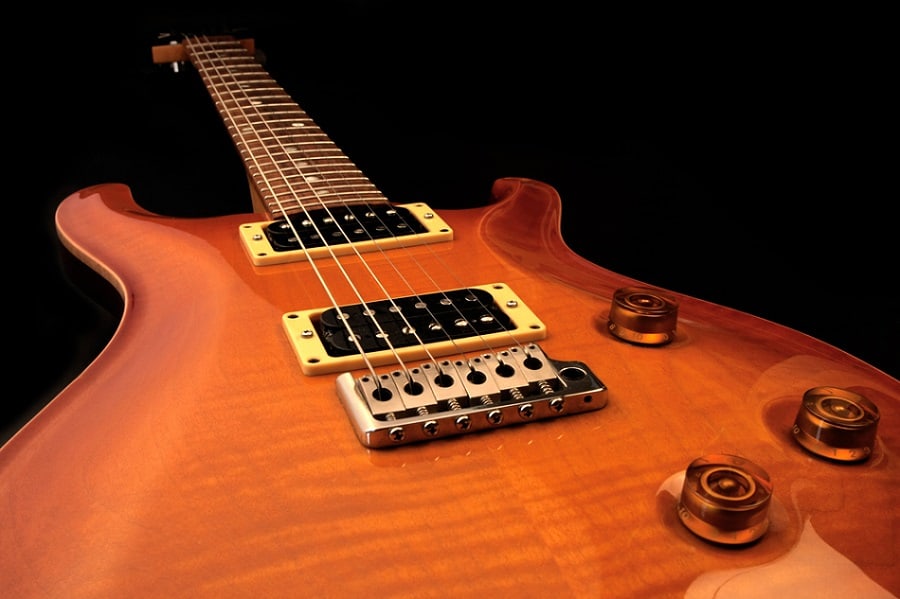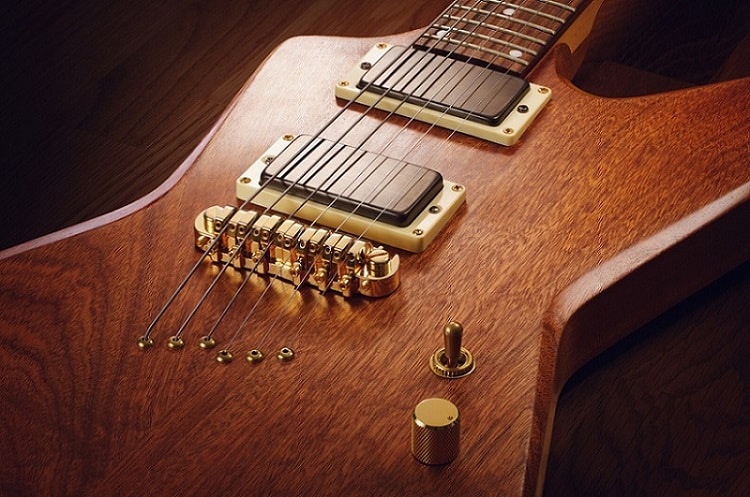Let’s be honest. Part of the reason we love guitars is because they’re beautiful!
Perhaps you like a particular guitar shape. Maybe you’ve got your heart set on a specific color.
But the thing that really makes a guitar eye-catching is the finish.
Nitro lacquer is one of the most common finishes to see on a guitar. It’s beautifully shiny, but it has some downsides.
If you’re looking for alternatives to nitro lacquer guitar, I’m exploring 5 different options. I’ll share the pros and cons of each one so you can find what’s right for you!
Why Is Guitar Finish Important?
Your guitar’s finish serves two purposes. First, it gives your guitar a specific look. More importantly, it protects your guitar from the outside world.
The guitar’s finish seals and protects the quality of the wood. It can make it less prone to warping, help the tone wood retain its musical tone, and offer some resistance to bumps and scratches.
If you’re considering refinishing your guitar but don’t know where to begin, here’s a handy tutorial.
The Full Scoop on Nitro Lacquer Finish
Many guitars have a nitro lacquer finish. It was both Gibson and Fender’s finish of choice in the 50’s and 60’s, and many brands still use it today.
It’s made from a mix of nitrocellulose and a solvent. Interestingly, it was originally planned as a spray-on paint for vehicles.
A nitro lacquer finish has some big advantages. First, its beautiful, mirror-like gloss. If you’ve ever seen a guitar that looks like it shines in the light, it’s likely to be nitro. It also enhances the color quite a bit.
Here’s an example of a Gibson with a nitro lacquer finish, so you can see it in all its glory!

Secondly, nitro doesn’t change the guitar’s tone. It’s an airy finish that allows the guitar’s original sound to come through, while still protecting the wood.
So, why are we looking at alternatives if nitro is great?
The Disadvantages of Nitro Lacquer On a Guitar
Well, this eye-catching finish has some significant disadvantages. For luthiers, the pros may outweigh the cons. But for everyday guitarists who want to refinish their guitar, there are downsides.
Firstly, it’s time-consuming to apply. It has to be applied over a few days, adding each new coating once the previous one has completely dried. After that, it needs to be buffed and polished to create the fine shine.
The solvent in the nitro finish continuously evaporates. This causes yellowing, which can look awesomely vintage on some guitars but not so great on others.
It’s also prone to wear and tear. Small cracks are inevitable as the finish ages. Again, if you’re after an old-school look, this could be cool. But some guitarists feel that this ruins the aesthetics of their instrument.
One of the biggest downfalls of nitro lacquer is that applying it produces toxic fumes. You’ll need to wear appropriate gear to protect yourself.
But even if you’re protected, the toxic nature of the stuff may pose other problems. It’s not as environmentally-friendly as other finishes, and could be hazardous to kids and pets in the home. This alone may put people off using it.
Because nitrocellulose is volatile and toxic, its use is regulated in some areas. Being shiny and easy to clean aren’t enough to give this finish a full thumbs-up.
What I Like
- Aesthetically pleasing
- Smooth, glossy finish
- Easy to repair
- Excellent sound quality
- Impressive color quality
What I Don’t Like
- Difficult to apply
- Toxic
- Cracks over time
- May discolor over time
- Prone to wear and tear
- Takes a long time to cure
- Expensive
5 Alternatives to Nitro Lacquer On Your Guitar
1. Polyurethane/Polyester
These two are both plastic-based finishes. Post-60’s Fender guitars and Paul Reed Smith guitars used these finishes. Today, they’re considered the industry standard.
There are different types of polyurethane. Some are thick and glossy, others thinner and more satiny. Both glossy polyurethane and polyester give the guitar a shiny, smooth coating.
Here’s an example of a poly coating so you can compare it to the nitro coating on the Gibson pictured above:

Still pretty shiny, right?
Poly finishes have a ton of advantages:
Cured polyurethane finish is not toxic. Even better, polyurethane is easier and less time-consuming to apply than nitro.
These finishes are also far stronger and more durable than nitro. They don’t fade or discolor, and are difficult to scratch or nick.
There’s one possible downside to poly finishes. They may not preserve the sound quality of your guitar as well as nitro.
But this is unlikely to be a huge difference, especially for casual guitarists. Generally, an amp or effects pedal can be used to get the tone you want on acoustic, electric, or bass guitars.
What I Like
- Highly durable
- Needs fewer coats to seal
- Mirror-like shiny quality
- Thicker and stronger than nitro
What I Don’t Like
- Need good technique to apply evenly
- May be less acoustically-resonant
2. Shellac
Shellac is another popular finishing choice, and was used by Martin guitars for a good century or so. It’s an all-natural resin, and comes in a variety of shades.
Here’s an example of the type of look you can get with a shellac finish. It also shows how easy it is to apply!
If you’re after a warm, natural wood look, shellac is a great alternative finish.
For a more glossy look, you can try something called French Polishing. It’s typically used on furniture and it’s more time-consuming than just applying shellac. But it leaves a stunning gloss.
The bad side to shellac is that it’s not heat-resistant at all. If you finish your guitar with shellac, make sure it stays away from humidity and heat.
What I Like
- Warm color & feeling
- Safe for health
- Easy to apply
- All-natural product
What I Don’t Like
- Not heat-resistant at all
- Not as glossy as lacquer
- French polishing can be finicky
3. Oil and Wax-Based Finishes
Oil and wax finishes are some of the oldest, but they’re not used much in modern times. They typically use an oil layer topped by a wax coating.
So what’s great about oil and wax finishes?
If you’re looking for something all-natural, environmentally-friendly, and safe, oil and wax are good choices.
They’re super for acoustic guitars, as they’re lightweight and easy to apply. Also, the natural tone of your guitar won’t be dampened by a layer of wax or oil.
They also make the wood grain of your guitar stand out beautifully!

If you’re looking to protect your guitar from scratches and bumps, these finishes are not the best option.
The wood also needs to be prepped beforehand. I mainly recommend oil and wood for experienced guitar-makers. Hobbyists who want something new and natural-looking may also like to try it.
It may not be the best or easiest for new luthiers. Hard rock or metal guitarists who throw their instruments around a bit may also prefer something more hardy.
What I Like
- All-natural and non-toxic
- Environmentally-friendly
- Retains excellent tone
- Enhance natural wood grain
What I Don’t Like
- Not very protective
- Requires prep work to the wood beforehand
4. Acrylic Lacquer
Acrylic lacquers look quite similar to polyurethane. In fact, many of Fender’s metallic finishes are acrylic!
Here’s a helpful rundown of the important differences between the two.
Acrylics are water-based synthetic resins. This makes them safe to use as they contain no solvents.
They also dry much quicker than others. You’ll need to apply a good few coats, but they dry extremely quickly. You can even help them along using a heat gun (or hairdryer!).
Acrylic is an excellent choice for those who are new to applying guitar finishes. It’s relatively simple to apply and easier to get on evenly than PU.
What I Like
- Dries very quickly
- Can heat to dry
- Similar aesthetics to poly finish
- Water-based
What I Don’t Like
- Can be pricey
5. UV-Cured Finish
UV is not a finish in itself. Rather, it’s a way of curing your guitar finish so that it’s highly durable and dries in minutes instead of hours.
But UV guitar finishes have one huge disadvantage – they cost a fortune!
There are a variety of UV-cure materials that you can use before applying the UV light. Poly coatings can be made UV-friendly by adding a photoinitiator.
These substances absorb UV light and transform it into a chemical reaction. Finding one and understanding how to add it to your poly coating can be complicated, though.
Apart from the finish material, you’ll need a rather elaborate setup to do this properly. This blog post gives a good idea of how to set yourself up to do UV finishes.
You’ll also need to take safety precautions. You’re essentially working with radiation! It can also be messy, finicky, and take time to get right.
Luthiers who are manufacturing guitars in large quantities may find it useful. But casual guitarists who would just like to finish their own guitar may be out of their depth.
What I Like
- Dries quickly
- Tough and durable
What I Don’t Like
- Requires expensive equipment
- Can be dangerous
- Not worthwhile unless mass producing
Conclusion
Whether you’re building your own guitar or simply refinishing it, finishing options abound.
Nitro looks amazing and creates a mirror-like sheen. But it’s difficult and time-consuming to apply, and can be toxic! If you can deal with that, then nitro lacquer makes for stunning finishes.
If you’d prefer something safer and easier to apply (that may look just as great), you may want to consider one of these 5 alternatives to nitro lacquer on your guitar.
Thanks for reading!
To learn more about different guitar features, why not check out my post on the benefits of low guitar action (and how to adjust your action), the benefits of big guitar picks, or whether tall guitar players have an advantage?

